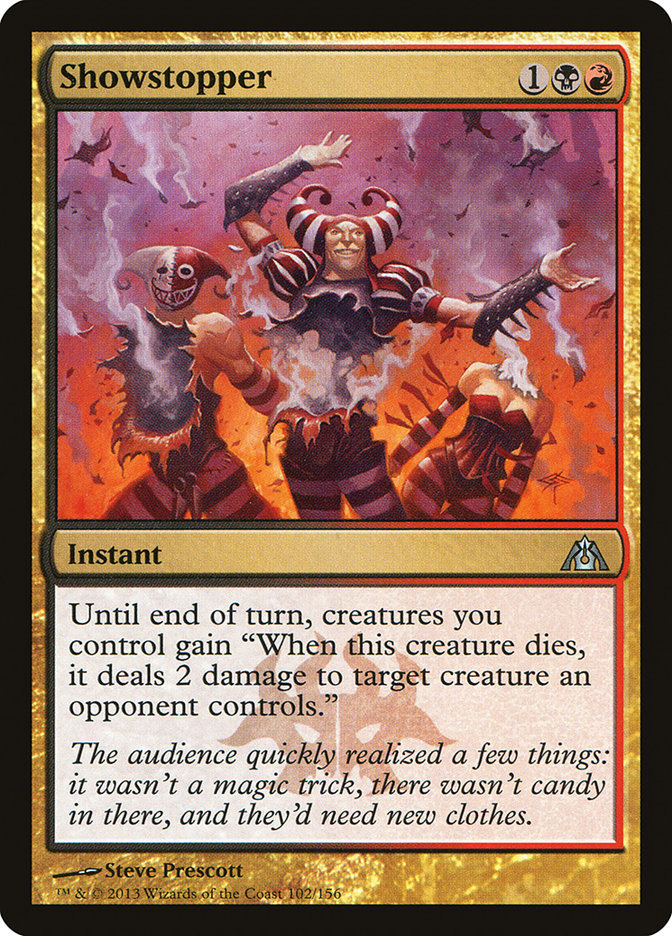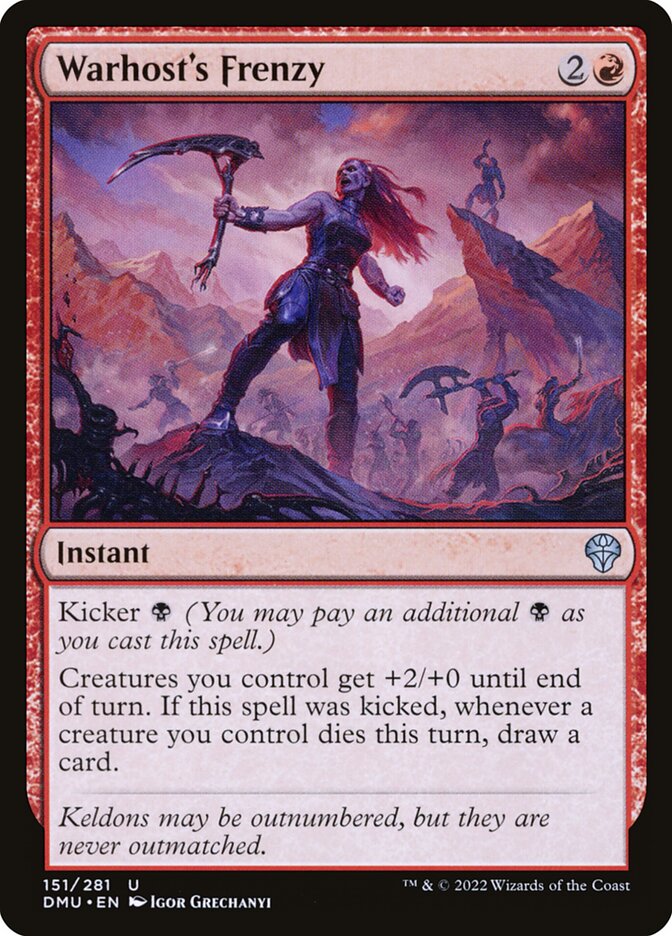Delirio Carta MTG
| El coste de maná | |
| Costo de maná convertido | 3 |
| Rareza | Poco común |
| Tipo | |
| Liberado | 1996-10-08 |
| Coleccione símbolo | |
| Coleccione nombre | Mirage |
| Coleccione código | MIR |
| Número | 260 |
| Frame | 1997 |
| Disposición | Normal |
| Border | Negra |
| Ilustrado por | Terese Nielsen |
Texto de la carta
Juega solo en el turno del oponente objetivo. Gira la criatura objetivo que controla ese jugador. Esa criatura hace al jugador una cantidad de daño igual a su fuerza. La criatura ni inflige ni recibe daño de combate este turno.
Cartas Similares
La Locura es un interesante mecanismo en MTG que recompensa a los jugadores por tener un conjunto diverso de tipos de cartas en su cementerio. Puede tener un efecto sorprendentemente similar al mecanismo de Umbral que también cuenta el número de cartas en tu cementerio pero se activa una vez que hay siete o más cartas. Mientras que Umbral solo se preocupa por el número total, la Locura se enfoca en la variedad, requiriendo cuatro tipos de cartas diferentes para lograr sus beneficios, añadiendo así una capa de complejidad y estrategia a la construcción del mazo.
Mecánicas como la Morbosidad también se pueden comparar con la Locura, ya que ambas se basan en el estado del juego, con la Morbosidad activándose cuando una criatura ha muerto durante el turno. Sin embargo, las condiciones de la Morbosidad son específicas y mucho más inmediatas en comparación con el requisito continuo de la Locura. En una tangente ligeramente diferente está el mecanismo de Revuelta, que se activa siempre que un permanente que controlabas abandonó el campo de batalla en este turno. Comparte el tema de interacción con el cementerio, pero se enfoca en aquellos que abandonan el campo de batalla en lugar de lo que ya está en el cementerio.
Al evaluar la Locura dentro del contexto más amplio de los mecanismos centrados en el cementerio de MTG, destaca por su requisito de diversidad en el cementerio y tiene un impacto duradero en la jugabilidad, ofreciendo ventajas continuas y variadas una vez que se cumplen sus condiciones.
Cartas similares a Delirio por color, tipo y coste de maná
Aspectos positivos de las cartas
Ventaja de cartas: Delirio es una palabra clave que te da una ventaja al proporcionar beneficios adicionales si hay suficientes tipos de cartas en tu cementerio. Promueve la construcción estratégica de mazos y jugadas inteligentes para inclinar la balanza a tu favor con efectos adicionales que a menudo conducen a robar cartas adicionales o interrumpir la estrategia de tu oponente.
Aceleración de recursos: Las cartas con la capacidad de delirio pueden acelerar tus recursos al permitir efectos más potentes una vez que el delirio está activo. Esto puede llevar a jugadas eficientes en costos y a una presencia en mesa más formidable, a menudo permitiéndote desplegar amenazas o respuestas mucho más fuertes de lo que normalmente obtendrías por el mismo costo.
Velocidad instantánea: Muchos habilitadores de delirio funcionan a velocidad instanánea, dándote la flexibilidad para impactar el juego durante el turno de tu oponente. Este elemento sorpresa puede cambiar el rumbo del juego a tu favor, ayudándote a alcanzar el estado de delirio de manera más impredecible desde la perspectiva de tu oponente.
Aspectos negativos de las cartas
Requisito de descarte: Navegar por los mecanismos de Delirio a menudo requiere tener una cierta variedad de tipos de cartas en tu cementerio. Esto puede obligarte a descartar cartas estratégicamente útiles antes de lo preferido, debilitando potencialmente tu plan de juego o dejándote en desventaja.
Costo específico de maná: Algunas cartas de Delirio tienen un costo de maná que las hace específicas de un color, restringiéndolas a ciertos tipos de mazos. Los jugadores deben considerar cuidadosamente su base de maná para asegurarse de que puedan cumplir consistentemente con estos requisitos, limitando la flexibilidad de la carta.
Costo de maná comparativamente alto: Las cartas que habilitan el Delirio con frecuencia tienen un alto costo de maná, lo que puede frenar el impulso de tu mazo. Hay momentos en los que activar Delirio no es rentable, especialmente cuando hay cartas competidoras que ofrecen beneficios similares sin la elevada inversión de maná.
Razones para incluir en tu colección
Versatilidad: Delirio como mecánica ofrece flexibilidad, permitiendo que las cartas con esta habilidad se incluyan en una variedad de mazos. Fomenta una estrategia inteligente de construcción de mazos para maximizar su potencial en el juego.
Potencial de combo: Las cartas con Delirio tienen el potencial de desbloquear efectos poderosos cuando se cumple la condición de tener cuatro o más tipos de cartas en el cementerio, interactuando bien con varias mecánicas relacionadas con el cementerio.
Relevancia en el meta: Considerando que las estrategias relacionadas con el cementerio a menudo surgen en varios metas, tener cartas capaces de Delirio puede dar a los jugadores una ventaja al utilizar recursos que normalmente son más difíciles de interrumpir para los oponentes.
Cómo vencer
Cuando te enfrentas a un jugador que utiliza una carta con la mecánica de Delirio en MTG, el juego se convierte en una batalla estratégica contra el potencial de su cementerio. Las habilidades de Delirio se fortalecen significativamente cuando hay cuatro o más tipos de cartas entre las cartas en su cementerio. Por lo tanto, tu prioridad debe ser limitar su capacidad para manejar el contenido de su cementerio. Cartas con odio al cementerio como Scavenging Ooze o Rest in Peace pueden obstaculizar gravemente la estrategia de Delirio de tu oponente. Estas perturban su habilidad para lograr la diversidad necesaria de tipos de cartas en su cementerio.
Monitorear el cementerio de tu oponente es crucial también, asegurándote de reaccionar antes de que alcancen el umbral crítico de cuatro tipos de cartas diferentes. La interrupción de mano o los hechizos que exilien cartas del cementerio podrían ser tus principales herramientas para mantenerte un paso adelante. Se convierte en un juego de previsión y control, ya que debes gestionar proactivamente tanto su tablero como su cementerio para mitigar toda la potencia de sus capacidades de Delirio.
Recuerda, vencer exitosamente las estrategias de Delirio depende de tu habilidad para predecir, interactuar y responder a las tácticas de manipulación de cementerios, convirtiendo finalmente la fortaleza de tu oponente en su debilidad.
Recomendaciones de BurnMana
Comprender las configuraciones de Delirio dentro de tu arsenal de MTG puede mejorar significativamente tu estrategia, ya sea que prefieras comandar una amplia variedad de cartas o adaptar un mazo específico. Adentrarse en las sutilezas de las mecánicas del cementerio e integrar cartas orientadas hacia el Delirio puede cambiar el juego, especialmente para jugadores que buscan una ventaja táctica a través de la diversidad y la aceleración de recursos. Sin embargo, también es esencial protegerse contra las desventajas de la mecánica y utilizar cartas que contrarresten sus exigencias. Nuestras ideas cuidadosamente seleccionadas te guiarán para aprovechar el potencial de tu colección y navegar la danza intrincada de la metajuego de MTG. Para descubrir más ideas que perfeccionen tu mazo y redefinan tu juego, únete a nosotros en BurnMana.
Donde comprar
Si estás buscando comprar una carta MTG Delirio de un coleccione específico como Mirage, existen varias opciones confiables que debes considerar. Una de las fuentes principales es tu tienda de juegos local, donde a menudo puedes encontrar paquetes de refuerzo, cartas individuales y mazos preconstruidos de colecciones actuales y pasadas. A menudo ofrecen el beneficio adicional de una comunidad donde puedes intercambiar con otros jugadores.
Para un inventario más amplio, particularmente de colecciones más antiguos, mercados en línea como TCGPlayer, Card Kingdom y Card Market ofrecen amplias selecciones y te permiten buscar cartas de colecciones específicos. Las plataformas de comercio electrónico más grandes como eBay y Amazon también tienen listados de varios vendedores, lo que puede ser un buen lugar para buscar productos sellados y hallazgos raros.
Además, el sitio oficial de Magic suele tener un localizador de tiendas y listas de minoristas para encontrar Wizards of the Productos con licencia costera. Recuerde comprobar la autenticidad y el estado de las cartas al comprarlas, especialmente a vendedores individuales en mercados más grandes.
A continuación se muestra una lista de algunos sitios web de tiendas donde puede comprar las Delirio y otras cartas MTG:
 COMPRAR
COMPRAR BurnMana es un socio oficial de TCGPlayer
- eBay
- Card Kingdom
- Card Market
- Star City Games
- CoolStuffInc
- MTG Mint Card
- Hareruya
- Troll and Toad
- ABU Games
- Card Hoarder Magic Online
- MTGO Traders Magic Online
Ver productos MTG
Legalidades
Formatos de Magic the Gathering donde Delirio tiene restricciones
| Formato | Legalidad |
|---|---|
| Commander | Legal |
| Legacy | Legal |
| Oathbreaker | Legal |
| Premodern | Legal |
| Vintage | Legal |
| Duel | Legal |
| Predh | Legal |
Reglas e información
La guía de referencia para las reglas de las cartas Delirio de Magic: The Gathering proporciona las reglas oficiales, las erratas emitidas, así como un registro de todas las modificaciones funcionales que se han producido.
| Fecha | Texto |
|---|---|
| 04/10/2004 | Tocar la criatura es parte del efecto y no del costo, por lo tanto puedes lanzar esto apuntando a una criatura girada. |












